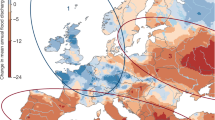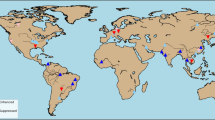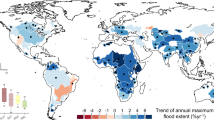Abstract
Extreme river floods have been a substantial natural hazard in Europe over the past centuries1, and radiative effects of recent anthropogenic changes in atmospheric composition are expected to cause climate changes, especially enhancement of the hydrological cycle2, leading to an increased flood risk3,4. For the past few decades, however, observations from Europe1,5,6,7 do not show a clear increase in flood occurrence rate. Here we present longer-term records of winter and summer floods in two of the largest rivers in central Europe, the Elbe and Oder rivers. For the past 80 to 150 yr, we find a decrease in winter flood occurrence in both rivers, while summer floods show no trend, consistent with trends in extreme precipitation occurrence. The reduction in winter flood occurrence can partly be attributed to fewer events of strong freezing—following such events, breaking river ice at the end of the winter may function as a water barrier and enhance floods severely. Additionally, we detect significant long-term changes in flood occurrence rates in the sixteenth to nineteenth centuries, and conclude that reductions in river length, construction of reservoirs and deforestation have had minor effects on flood frequency.
This is a preview of subscription content, access via your institution
Access options
Subscribe to this journal
Receive 51 print issues and online access
$199.00 per year
only $3.90 per issue
Buy this article
- Purchase on Springer Link
- Instant access to full article PDF
Prices may be subject to local taxes which are calculated during checkout



Similar content being viewed by others
References
Glaser, R. Klimageschichte Mitteleuropas (WBG, Darmstadt, 2001)
Giorgi, F. et al. in Climate Change 2001: The Scientific Basis (eds Houghton, J. T. et al.) 583–638 (Cambridge Univ. Press, Cambridge, 2001)
Palmer, T. N. & Räisänen, J. Quantifying the risk of extreme seasonal precipitation events in a changing climate. Nature 415, 512–514 (2002)
Christensen, J. H. & Christensen, O. B. Severe summertime flooding in Europe. Nature 421, 805–806 (2003)
Disse, M. & Engel, H. Flood events in the Rhine basin: Genesis, influences and mitigation. Nat. Hazards 23, 271–290 (2001)
Sturm, K. et al. Hochwasser in Mitteleuropa seit 1500 und ihre Beziehung zur atmosphärischen Zirkulation. Petermanns Geogr. Mitt. 145, 14–23 (2001)
Robson, A. J. Evidence for trends in UK flooding. Phil. Trans. R. Soc. Lond. A 360, 1327–1343 (2002)
Fischer, K. Die Sommerhochwasser der Oder von 1813 bis 1903. Jb. Gewässerk. Norddeutsch. Besond. Mitt. 1, 1–101 (1907)
Grünewald, U. et al. Ursachen, Verlauf und Folgen des Sommer-Hochwassers 1997 an der Oder sowie Aussagen zu bestehenden Risikopotentialen, Langfassung (IDNDR, Bonn, 1998)
Weikinn, C. Quellentexte zur Witterungsgeschichte Europas von der Zeitwende bis zum Jahre 1850: Hydrographie, Parts 1–4 (Akademie, Berlin, 1958–1963); Parts 5–6 (eds Börngen, M. & Tetzlaff, G.) (Gebrüder Borntraeger, Berlin, 2000–2002).
Pötzsch, C. G. Chronologische Geschichte der großen Wasserfluthen des Elbstroms seit tausend und mehr Jahren (Waltherische Hofbuchhandlung, Dresden, 1784)
Schäfer, W. Chronik der Dresdener Elbbrücke, nebst den Annalen der größten Elbfluthen von der frühesten bis auf die neueste Zeit (Adler und Dietze, Dresden, 1848)
Königliche Elbstrombauverwaltung Der Elbstrom, sein Stromgebiet und seine wichtigsten Nebenflüsse Vol. 3.1 (Reimer, Berlin, 1898)
Bureau des Ausschusses zur Untersuchung der Wasserverhältnisse in den der Überschwemmungsgefahr besonders ausgesetzten Flußgebieten Der Oderstrom, sein Stromgebiet und seine wichtigsten Nebenflüsse Vol. 3.1 (Reimer, Berlin, 1896)
Brázdil, R. et al. Flood events of selected European rivers in the sixteenth century. Clim. Change 43, 239–285 (1999)
Militzer, S. Klima, Umwelt, Mensch (1500–1800): Studien und Quellen zur Bedeutung von Klima und Witterung in der vorindustriellen Gesellschaft (Historisches Seminar, Leipzig, 1998)
Königliche Elbstrom-Bauverwaltung Hydrologischer Jahresbericht von der Elbe für 1892 (Baensch, Magdeburg, 1893)
Helms, M., Ihringer, J. & Nestmann, F. in Morphodynamik der Elbe (eds Nestmann, F. & Büchele, B.) 91–202 (Institut für Wasserwirtschaft und Kulturtechnik TH Karlsruhe, Karlsruhe, 2002)
Oderstrombauverwaltung Mitteilungen der Oderstrombauverwaltung über die Strombauten, die Wasserstände und die Schiffahrtsverhältnisse der Oder, 1905–1906, 1911–1926, 1927–1929, 1930–1932, 1933–1936 (Oderstrombauverwaltung, Breslau, 1907–36)
Reiss, R.-D. & Thomas, M. Statistical Analysis of Extreme Values (Birkhäuser, Basel, 1997)
Cowling, A., Hall, P. & Phillips, M. J. Bootstrap confidence regions for the intensity of a Poisson point process. J. Am. Statist. Assoc. 91, 1516–1524 (1996)
Mudelsee, M. XTREND: A computer program for estimating trends in the occurrence rate of extreme weather and climate events. Sci. Rep. Inst. Meteorol. Univ. Leipzig 26, 149–195 (2002)
Bundesanstalt für Gewässerkunde, Untersuchungen zum Abflussregime der Elbe, (BfG, Berlin, 2000)
Bronstert, A., Bismuth, C. & Menzel, L. (eds) Proc. European Conf. on Advances in Flood Research (Report No. 65, Potsdam Institute for Climate Impact Research, Potsdam, 2000)
Hulme, M., Osborn, T. J. & Johns, T. C. Precipitation sensitivity to global warming: Comparison of observations with HadCM2 simulations. Geophys. Res. Lett. 25, 3379–3382 (1998)
Folland, C. K. et al. in Climate Change 2001: The Scientific Basis (eds Houghton, J. T. et al.) 99–181 (Cambridge Univ. Press, Cambridge, 2001)
Luterbacher, J. et al. The late Maunder Minimum (1675–1715)—A key period for studying decadal scale climatic change in Europe. Clim. Change 49, 441–462 (2001)
Schmidt, M. Hochwasser und Hochwasserschutz in Deutschland vor 1850 (Oldenbourg, Munich, 2000)
Cox, D. R. & Lewis, P. A. W. The Statistical Analysis of Series of Events (Methuen, London, 1966)
Acknowledgements
We thank J. Jacobeit, J. Luterbacher and M. Schulz for comments, and N. Conrads, H. Engel, W. Fröhlich, T. Lüllwitz, J. Munzar, R. Oppermann as well as GRDC (Germany) and NOAA (USA) for data. This work was supported by the Deutsche Forschungsgemeinschaft.
Author information
Authors and Affiliations
Corresponding author
Ethics declarations
Competing interests
The authors declare that they have no competing financial interests.
Rights and permissions
About this article
Cite this article
Mudelsee, M., Börngen, M., Tetzlaff, G. et al. No upward trends in the occurrence of extreme floods in central Europe. Nature 425, 166–169 (2003). https://doi.org/10.1038/nature01928
Received:
Accepted:
Issue Date:
DOI: https://doi.org/10.1038/nature01928
This article is cited by
-
Changes in streamflow drought and flood distribution over Poland using trend decomposition
Acta Geophysica (2023)
-
Drought and deluge: the recurrence of hydroclimate extremes during the past 600 years in eastern Australia’s Natural Resource Management (NRM) clusters
Natural Hazards (2023)
-
Reconciling disagreement on global river flood changes in a warming climate
Nature Climate Change (2022)
-
Impact of warmer climate periods on flood hazard in the European Alps
Nature Geoscience (2022)
-
Nonstationary footprints of ENSO in the Mekong River Delta hydrology
Scientific Reports (2022)
Comments
By submitting a comment you agree to abide by our Terms and Community Guidelines. If you find something abusive or that does not comply with our terms or guidelines please flag it as inappropriate.



